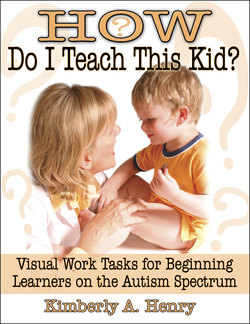Читать книгу How Do I Teach This Kid? - Kimberly A. Henry - Страница 8
На сайте Литреса книга снята с продажи.
ОглавлениеCreating A Work System
Like task boxes, work systems capitalize on students’ visual strengths and can be tailored to the unique abilities of the child. A work system teaches a child what and how much work is to be completed and when it is finished. To achieve these goals, a work system follows the same principles as work tasks: visual organization and visual clarity. Tasks to be completed are presented in a systematic fashion with minimal distractors or irrelevant material. When a work system is first introduced, direct instruction must occur to teach a child how to follow the system—how to get the tasks, complete them, and where to put them when they are finished.
In a structured work system, work routinely flows from left to right. Tasks to be completed are placed on the student’s left. One task at a time is brought to the work surface, completed, and then transferred to a “finished” area to the student’s right. It is often helpful to have a shelving unit on the left of the student to hold the tasks to be completed in an organized fashion. Shelves for finished tasks may also be on the right of the student. However, some people prefer to use a laundry basket or other large container for finished work. The child completes the work and then places it in the “finished basket” on the floor to his right. One example of this type of work system organization is depicted in the photo on the next page:
A schedule of work to be completed may also assist some students in finishing the tasks independently. The schedule should match coding on the task boxes—colors, letters, numbers, pictures, etc. A schedule strip can be mounted to the work surface in front of the child. The schedule defines the order in which the child is to complete the tasks on his left. For example, a schedule strip may contain a green square of paper, a red square, and a yellow square, attached to the strip with Velcro®. Each box to be completed has a matching green, red, or yellow square on the outside of the box. The child will remove the first colored square, match it to the outside of the box with the same color square and then complete the task in the box. A piece of loop-Velcro® is placed on the colored square. The photo on the next page illustrates an example of a schedule strip with cards to be matched to the outside of the task box.
